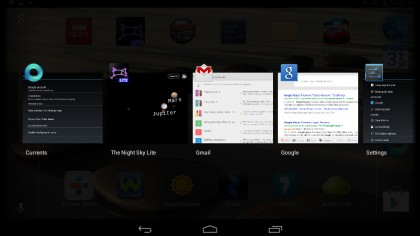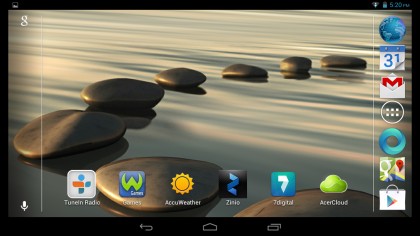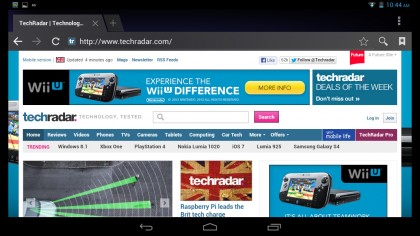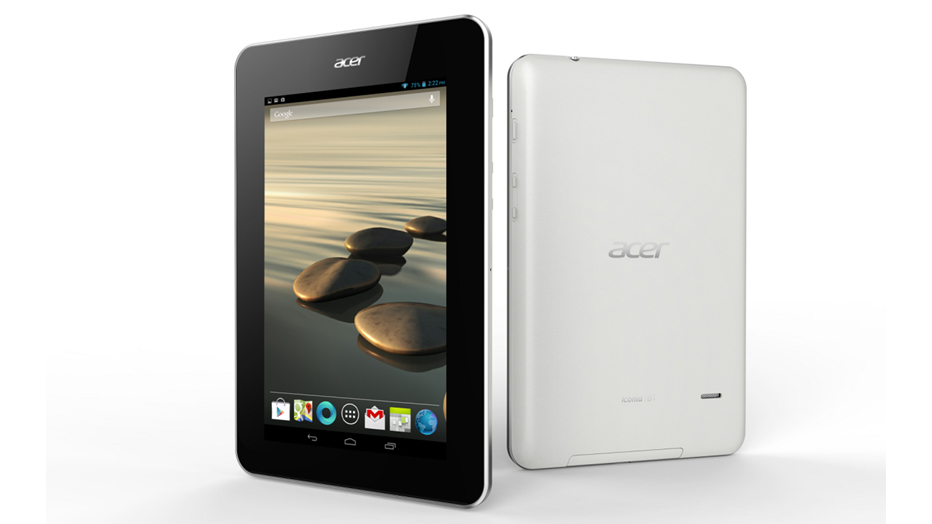Why you can trust TechRadar
We have an instant dislike for the Acer Iconia B1's 17:10 screen aspect ratio. Having been impressed by - and even got used to - the extra real estate offered by 4:3-shaped tablets, the Acer Iconia B1's dimensions make it more difficult to use while in landscape orientation.
Fewer apps fit on the screen, and browsing feels generally tighter. The Acer Iconia B1 also takes around three seconds to re-orient its screen when moved, which can slow things up a bit.
Still, what Acer's done for the interface is pleasant enough. In a slight mod to the usual Android Jelly Bean experience, Acer adds a taskbar that sits either on the bottom in portrait mode, or on the right-hand side when in landscape.

That taskbar is home to icons for the standard Android browser, Calendar, Gmail, a link to all apps, Google Play and Google Current. The taskbar can easily be customised and changed just by dragging apps on and off.
Also as a default, this time along the bottom of the tablet above the taskbar, are apps including TuneIn Radio, AccuWeather, Zinio, 7digital, Acer Cloud and Games. We'd rate all of those as useful, and everything is neatly presented.
The screen's touch-sensitivity isn't benchmark quality, but it's good enough - excepting a few blind spots - and its dual-core processor enabled us to skip around the interface easily enough.
We also managed to have several apps running in the background while browsing, and the Acer Iconia B1 didn't miss a beat. Only those moving down-market from, say, a Samsung Galaxy Note, iPad or even an Asus Fonepad (which we had alongside us during this review) will think the Acer Iconia B1 rather slow.

However, it's that screen that caused us the most problems. As well as being rather reflective, it's low resolution - and it shows. Either when browsing the web or watching video, the 1024 x 600 pixels are easily visible.
Video isn't exactly sharp, and we noticed a few jagged edges, too, though for most people it will suffice - and it's certainly fit for the likes of YouTube.
Brightness isn't a problem, with a drag-down panel giving a toggle for (just) three intensity settings. The lowest of these really is hardly visible, but it might help to eke out an extra few minutes of battery if the Acer Iconia B1 dies halfway through a long train journey (that's a very likely scenario) or for late-night reading.

Worse is to come if you squeeze the Acer Iconia B1, since its screen responds by solarising and staining, just as an old LCD monitor used to do when you touched it. Yuck.
Our other concern is with the viewing angles, which are so tight that they render the Acer Iconia B1 useless for sharing in meetings or even playing some games on. It stems from the panel not being IPS, which is pretty standard on tablets and TVs.
However, you could look at this as a plus-point, since the chap next to you on the bus won't be able to see what you're doing.
Browser
As a web browsing device, the Acer Iconia B1 passes easily. Acer may have cut corners elsewhere on the tablet, but it hasn't under-specced the processor - and that makes all the difference when browsing. Its dual-core processor proves its worth with speedy browsing while on Wi-Fi and opening pages quickly enough - though it's not a patch on the ultra-quick Asus Fonepad we had nearby.

The vanilla Android browser and Chrome app version's performances will suffice for most casual users, though power users beware.
Neither browser supports Adobe Flash, but video performance is otherwise strong. Video on the BBC News website played instantly in our test, while attempting the same from the BBC iPlayer website prompted the Acer Iconia B1 to visit the Google Play store to download the BBC Media Player software. However, when we returned to the website, the content didn't play, so we had to shut it all down and begin again.
Battery life
This is where the Acer Iconia B1 really trips up. Even Acer admits that the Acer Iconia B1 won't stretch beyond four hours, and by golly it's right.
Despite its rather chunky design, in our one-hour long Nyan Cat video test on YouTube - with the Acer Iconia B1 at full brightness - this fully-charged 7-inch tablet's 2710mAh battery crashed to just 55 per cent charge. That's pretty awful, and only half as long as the Google Nexus 7.
Benchmarks
The AnTuTu app produced a lowly score of just 5,825 on the Acer Iconia B1, which doesn't compare well to the 9,208 average score of the Asus FonePad. The Google Nexus 7 scores 12,726.

The Acer Iconia B1's Chrome browser app then scored a rather average 495 on the universal Peacekeeper browser test, its Android browser earning a similar 491.
SunSpider, a web-based Javascript test, produced scores of 1,619 and 1,828 apiece for the Acer Iconia B1's Chrome and default browsers, respectively. The Asus FonePad produced scores of 2,026 and 1,483.
These are all very average results, as you might expect, with the AnTuTu score suggesting that the Acer Iconia B1 is less of an all-rounder than higher-priced tablets.
Jamie is a freelance tech, travel and space journalist based in the UK. He’s been writing regularly for Techradar since it was launched in 2008 and also writes regularly for Forbes, The Telegraph, the South China Morning Post, Sky & Telescope and the Sky At Night magazine as well as other Future titles T3, Digital Camera World, All About Space and Space.com. He also edits two of his own websites, TravGear.com and WhenIsTheNextEclipse.com that reflect his obsession with travel gear and solar eclipse travel. He is the author of A Stargazing Program For Beginners (Springer, 2015),

